3 cheap & effective methods to clean grapes before you eat them!
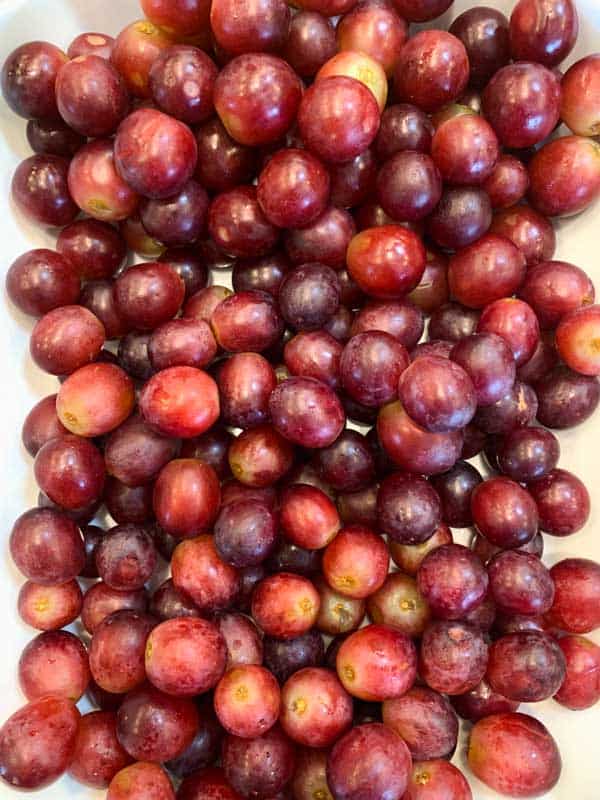
There’s a lot of different information floating around the interwebs about the proper way to wash grapes, what you need to do to remove pesticide residue, whether you even need to wash grapes in the first place…and I’ve got some answers for you.
First, let’s look at the different ways you can clean those suckers.
Method 1: Rinse With Plain Water
This is the simplest and quickest way to clean grapes.
Basic How-to
- Put the grapes you want to eat (or serve) into a colander in your sink.
- Run cool water over the grapes while gently “washing” them with your fingers. I usually simultaneously pop the grapes off the vine at this point, too.
- Give a final cool water rinse and you’re done.
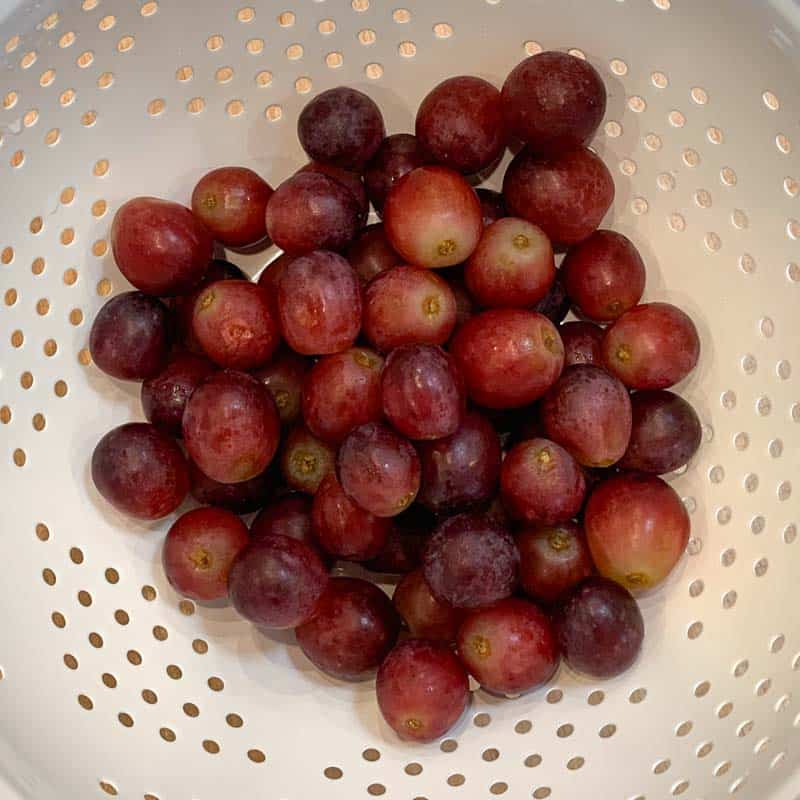
Method 2: Soak in Vinegar Water
You can use either apple cider vinegar (ACV) or white vinegar for this cleaning method. ACV is usually used for internal supplementation and in food recipes. White vinegar tends to be used more for cleaning. However, both vinegars have around the same percentage of acetic acid, in the 4-7% range. Vinegar has been shown to have antimicrobial properties which is the basis of this method for cleaning produce like grapes.
Basic How-to
- Fill a bowl with a solution of 1 part vinegar to 3 parts water.
- Add your grapes to the bowl. Let them soak for 5-30 minutes.
- Swish the grapes around in the bowl and wash with your fingers.
- Rinse with plain water.
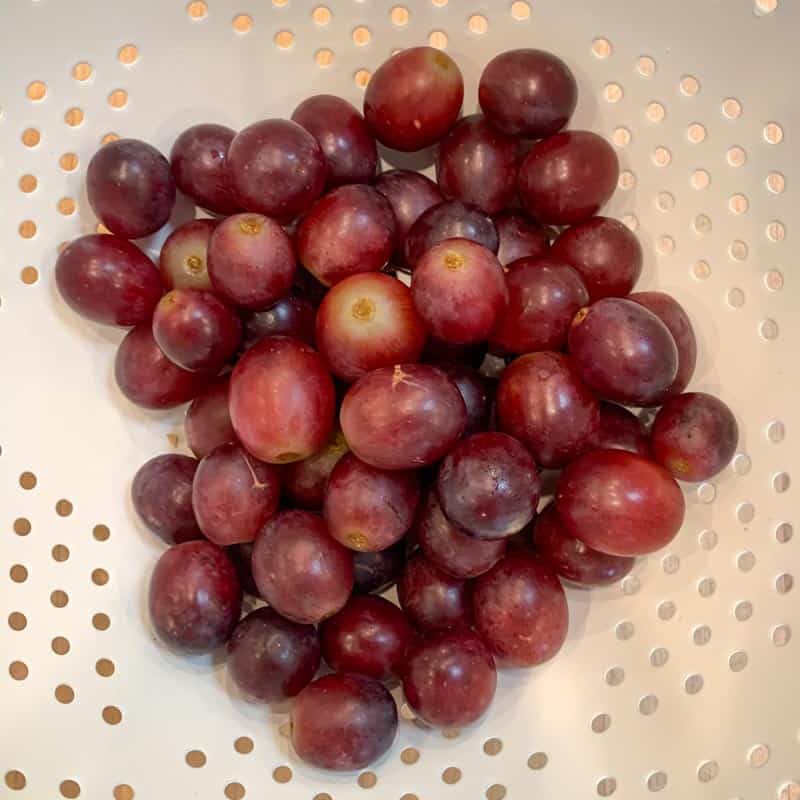
Method 3: Scrub With Baking Soda and/or Salt
In this method, you use the salt and/or baking soda as a food-safe abrasive to literally scrub off the bloom and residues on your grapes.
Basic How-to
- Start by rinsing the grapes with cool water.
- Put the rinsed grapes in a bowl.
- Sprinkle 2-3 teaspoons of baking soda, salt, or both on the grapes.
- Using your hands, gently stir the grapes and baking soda/salt together, scrubbing the grapes gently to remove as many residues as possible.
- Rinse the grapes thoroughly under cool water.
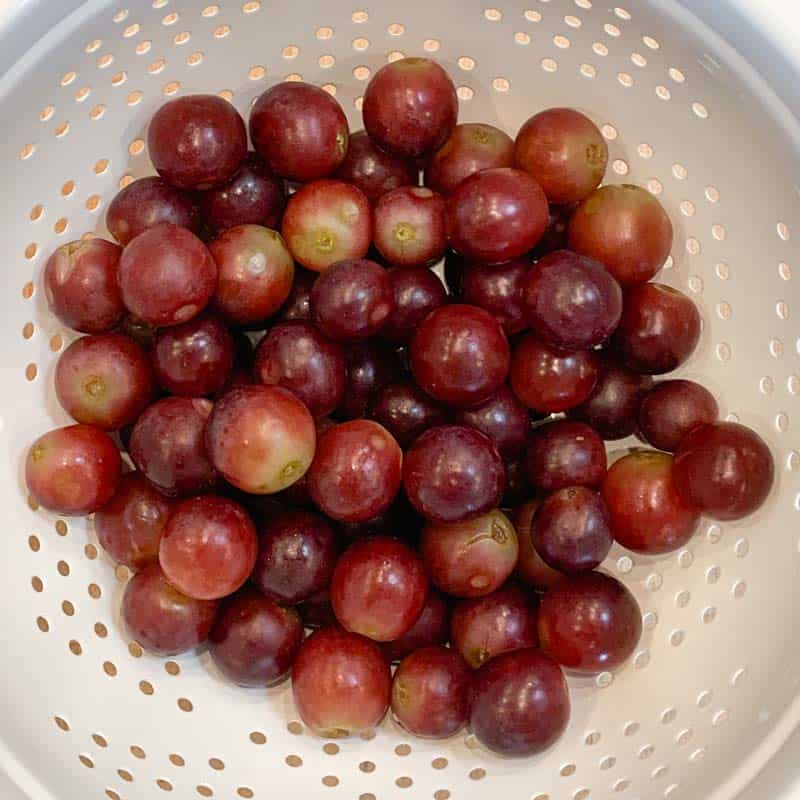
And a cleaning method I do NOT recommend
I also want to mention a method of cleaning grapes I’ve come across that I strongly discourage you from using, and that is to use flour as the scrubbing agent. The method is the same as using baking soda or salt, except you would use flour instead. Please don’t do this!
Here’s why. Celiac disease and gluten allergies and sensitivities are very common. As a mom of a kid with a severe allergy, I can tell you that fresh produce is one thing that those with allergies typically assume is safe. If you use flour to wash your grapes, they are in fact very unsafe for any person or child with an allergy. Even if you’re just cleaning grapes for your own household and not for a potluck or shared snack, I still urge you to use one of the other methods in this post instead of flour.
About Commercial Produce Washes
These washes have not been tested for efficacy or safety. In my opinion, they are at best a waste of money, and at worst add unnecessary chemicals to your produce. The methods described above are certainly as effective if not more effective than using commercial produce cleaner. Plus, these simple produce-cleaning methods are always going to be less expensive.
How to Store Grapes
You should keep freshly purchased grapes unwashed in the refrigerator in a crisper drawer if you have one and have space. Once you’ve cleaned your grapes, you’ve removed much of the protective bloom on them. This really speeds up the process of them drying out and going bad, so wait until you’re close to being ready to eat your grapes before you wash them. The rule of thumb I use is once they are washed, they need to be eaten within 12-24 hours.
What is the white coating on grapes?
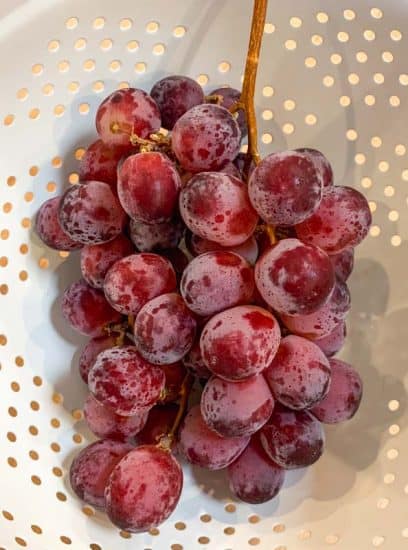
This whitish, chalky film on grapes (and also on blueberries) is called the “bloom.” It’s not dirt and it’s not pesticide. It’s actually a waxy coating that is produced by the plant itself and acts as a barrier to pests and bacteria. The bloom also helps prevent grapes from drying out because it seals in the berry’s juices.
You can use the presence of visible bloom on grapes as a measure of how fresh they are. This is because the white coating wears off fairly easily after the grapes are harvested and with the handling and manipulation from being packaged and shipped. If you see grapes at the store with a visible whitish coating, they are most likely fresh and juicy.
So is the bloom safe to eat?
Yes. Totally safe. But it might taste slightly bitter or leave a chalky feel in your mouth, so most prefer to wash it off.
To best remove a heavy bloom, I recommend either the vinegar soak method or the baking soda & salt scrub method above.
Do I really need to wash grapes before eating them?
Yeah, you really do. For two reasons. Pesticides. And bacteria.
Pesticides
What do they spray on grapes?
All conventionally grown grapes (not organic) are treated with a variety of synthetic chemical pesticides. There is a wide range of different types of chemicals that might be used. Chemicals may be sprayed directly on the fruit, sprayed onto the leaves, and/or injected into the soil.
Grapes are on the Dirty Dozen List
The Dirty Dozen is a list published each year by the Environmental Working Group. The list includes the 12 types of produce that have been found to contain the highest concentrations of pesticide residue.
EWG Dirty Dozen 2019
- strawberries
- grapes
- cherries
- peaches
- pears
- nectarines
- apples
- spinach
- kale
- tomatoes
- potatoes
- celery
Source: ewg.org
The EWG bases its list on lab test data collected by the Department of Agriculture. One important thing to know is that this testing is done on produce that has been prepared to be eaten. So bananas are tested for pesticides after the peel has been removed. And grapes are tested after they have been washed. This means that if you do not wash your grapes, you will be consuming even higher concentrations of pesticide residues.
Bacteria
Many types of bacteria can be found on all produce, regardless of whether it’s organic or conventionally-grown. There are lots of variables that affect which bacteria are on produce and how much bacteria. These variables include type of produce and farming method.
Which is Better? Organic or Conventionally-Grown Grapes
Organic grapes are grown without synthetic pesticides. Certified organic growers have to follow strict and very specific guidelines that control what they can use on their crops, and what they cannot. Instead of synthetic pesticides, they use less toxic substances and methods like soap sprays, mulch, and crop rotation to control pests and maximize crop yield.
If you buy organic, you do not need to be concerned about pesticide on your produce.
BUT…organic produce has surface bacteria just as conventionally-grown produce does, so you DO need to wash it.
Is it worth the risk of pesticide to eat non-organic grapes?
In short, yes.
If we all had access to affordable organic grapes, we would probably all choose those over conventionally grown ones. But because buying organic comes at a higher price-point and is not even an available option for everyone all year-round, it’s not that simple of a decision.
Given what we know about the pesticide residue on conventionally grown grapes, even after they have been washed, a lot of us are left feeling unsure about whether it’s worth the risk to eat grapes that aren’t organic. And some are choosing to skip eating the Dirty Dozen produce like grapes altogether if they are not organic.
This is NOT necessary, though. Do wash your produce thoroughly, but don’t skimp on fresh fruits and vegetables in your diet in order to avoid pesticides.
Even the Environmental Working Group, a leader in the cause against harmful chemicals being used in food and products, is very clear on their stance. Here’s what they say on their site.
EWG always recommends eating fruits and vegetables, even conventionally grown, instead of processed foods and other less healthy alternatives.
So if for any reason organic is not an option for you, it is much better to eat conventionally grown produce than it is to avoid eating it. Including produce on the Dirty Dozen list.
Just wash your grapes really well using one of the 3 methods in this post, and reap the benefits of including fresh fruits and veggies in your diet.
Resources:
- https://www.ewg.org/enviroblog/2016/05/five-essential-facts-about-pesticides-fruits-and-vegetables
- https://www.ewg.org/enviroblog/2008/01/ask-ewg-how-should-i-wash-my-fruits-and-veggies
- https://www.ams.usda.gov/datasets/pdp
- https://www.ncbi.nlm.nih.gov/pmc/articles/PMC3609859/
- https://www.ncbi.nlm.nih.gov/pmc/articles/PMC5788933/
- https://www.ncbi.nlm.nih.gov/pubmed/9713753
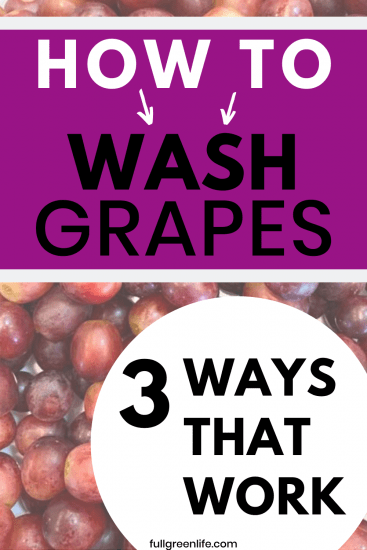

Jo Samuels says
I always leave the grapes attached to the vine after washing them off. To me, they stay fresh longer this way. Ones that are taken off tend to get soft quicker at the top where they were attached.